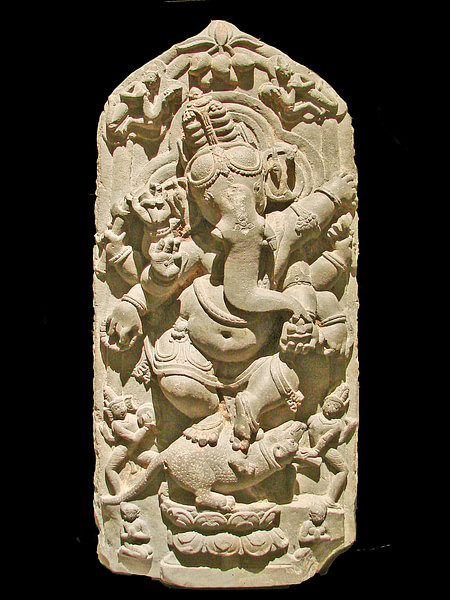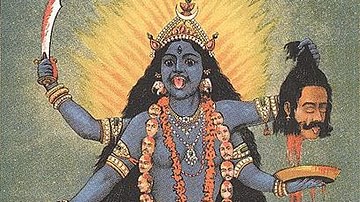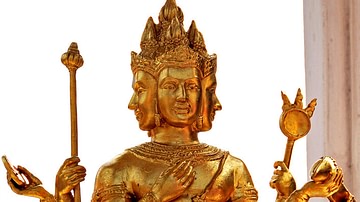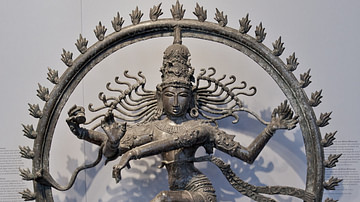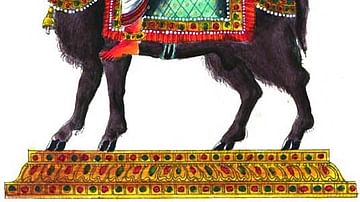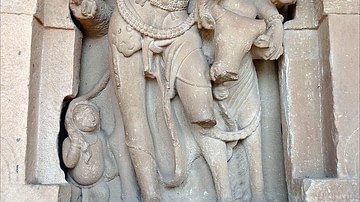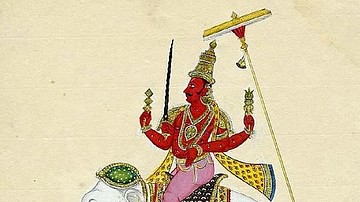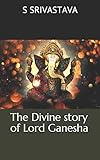
Ganesha (also Ganesa or Ganapati) is one of the most important gods in Hinduism. Ganesha is easily recognized with his elephant head and human body, representing the soul (atman) and the physical (maya). Ganesha is the patron of writers, travellers, students, and commerce, and he removes obstacles blocking new projects. The deity is fond of sweets, to the slight detriment of his figure.
Ganesha is also worshipped as a principal deity in both Jainism and Buddhism. For the Ganapatya Hindu sect, Ganesha is the most important deity.
Ganesha's Childhood
Ganesha is the son of Shiva and Parvati and he is the brother of Karthikeya (or Subrahmanya), the god of war. He was created by his mother using earth which she moulded into the shape of a boy. As Shiva was away on his meditative wanderings, Parvati set her new son as guard while she bathed. Unexpectedly, Shiva returned home and, on finding the boy, and outraged at his impudence in claiming he was Parvati's son, Shiva called for his gang of demons, the bhutaganas, who fought ferociously with the boy. However, the youngster easily held his own against such fearsome adversaries and Vishnu was forced to intervene in the form of Maya and, whilst the boy was distracted by her beauty, the demons, or Shiva himself, lopped off his head. At the commotion, Parvati ran from her bath and remonstrated with Shiva for so summarily killing their son. Repentant, Shiva ordered a new head to be found for the boy and, as the first animal available was an elephant, so Ganesha gained a new elephant head and became the most distinctive of the Hindu gods. As a reward for his great courage in fighting the demons, Shiva made Ganesha the leader of the bhutaganas, hence his name.
Ganesha's Adventures
A story which explains the god's association with intelligence and wisdom is his competition with Karthikeya to be the first to marry. They set up a challenge that whoever could first encircle the Earth would also find a bride first. Not wasting a second, Karthikeya swiftly mounted his blue peacock and immediately shot off around the world. Ganesha, on the other hand, casually sauntered over to his parents' house, embraced them and quoted the line from the sacred Vedas: “he who embraces his parents seven times (pradakshinas) gains the merit of encircling the world seven times”. Declared the winner, Ganesha promptly married not one but two daughters of Prajapati: Buddhi (Wisdom) and Siddhi (Success), with whom he had two sons: Kshema and Laabha.
Despite being a Hindu deity, Ganesha also has something of a reputation for greediness. One day, after eating a few too many modakas (sacrificial cakes), Ganesha decided to take a ride on his giant rat, Kroncha, to aid his digestion. However, the rat was surprised when he came across a large snake and, jumping back with fear, he threw off his mount. Ganesha landed on his full belly and it burst on hitting the ground. The cakes from his stomach rolled left, right and centre but Ganesha, unperturbed, carefully gathered them in, stuffed them all back into his belly and wound the snake around his midriff to keep it closed. Symbolic of Ganesha's ability to overcome all obstacles, the snake, the cause of the accident in the first place, therefore provided the remedy for the damage it had caused.
Ganesha's Broken Tusk
Continuing on his night-ride, Ganesha suddenly heard a thunderous noise from the heavens. This was the laughing of the Moon and his wives, the 27 Constellations, unable to contain themselves on seeing Ganesha wrapped in a snake. Outraged, Ganesha broke off the end of one of his tusks and hurled it at the laughing Moon who, hit full in the face, was struck black. Without the light of the moon, the dark nights became the haunt of thieves and villains until honest people had had enough and pleaded with the gods to restore the silver light. The gods asked Ganesha to forgive the Moon but only a partial forgiveness was given. Consequently, only periodically, on one night, would the Moon give his full light and then he would slowly waste away.
An alternative explanation of Ganesha's broken tusk is that of Krishna throwing his axe at Ganesha after he blocked his entrance to the private apartments of his parents Shiva and Parvati. Ganesha allowed the axe to hit and break his tusk so that no one could say that the axe, which was in fact his father's, was not a fearsome weapon. Yet another but less picturesque explanation of Ganesha's broken tusk was that he snapped it off in order to transcribe the epic poem Mahabharata, dictated by the sage Vyasa who wished to preserve the story for all time. This version explains Ganesha's association with writers and intellectuals.
How is Ganesha Represented in Art?
In Hindu art Ganesha is variously portrayed depending on specific cultures – Indian, Cambodian, Javanese etc. but he is most often depicted with the head of an elephant and a rather portly human body. In his hands he often carries a broken tusk, an axe, a ladle, a noose, prayer beads and a tray or bowl of sweets. He sometimes also wields an elephant goad in order to master life's obstacles. Ganesha is often depicted riding Kroncha, his giant rat, famed for its agility and also symbolic of the god's ability to circumvent obstacles.
